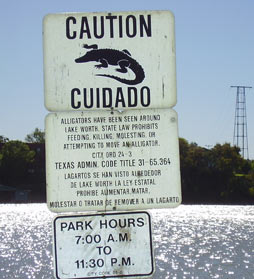By Katie Hudson-Martinez/feature editor

Looking at Fort Worth’s sprawling metropolis, it is hard to believe this area was densely populated with “dangerous” animals as recently as a hundred years ago.
Black bears, mountain lions and bison once had the run of the land, but ever-expanding development has made many of these wild animals non-existent in the area.
People still see coyotes and jackrabbits, opossums and raccoons.
Some people see alligators.
That’s right, alligators.
For the past 65 million years, since Tyrannosaurus were running around Texas, there have been alligators in Texas waterways.
Many scientists believe they were here long before humans even existed, and they are definitely here now.
American alligators around Tarrant County were hunted almost to extinction and placed on the endangered species list in the early 1960s, but protection enabled them to recover, and they have been removed from the list.
An influx of sightings in recent years prompted the Texas Parks and Wildlife Department to post signs at some area lakes, warning swimmers of an alligator population.
“ The alligators have always been here,” Captain Scott Haney, Fort Worth game warden, said. “It’s just that people are encroaching on their natural habitat more and more, and so people are coming into contact with the animals more frequently.”
He said people have a natural tendency to panic when they see an alligator in the wild, but they pose very little danger to humans.
“ There is no record of any person being killed by an alligator in Texas,” he said. “There have been 17 people injured by Texas alligators in the past 15 years, but the majority of those were handlers.”
Haney said they receive a handful of calls each year, but the wildlife department’s policy is to leave the animals alone unless they display aggression toward people, and he cannot recall any time that a Fort Worth area alligator showed signs of danger.

He suggests the best place in Tarrant County for people who want to try and see an alligator is the Fort Worth Nature Center and Refuge, a 3,600-acre nature preserve near Lake Worth.
Suzanne Tuttle, Nature Center manager, says Center staff has identified at least 10 individual alligators who have made their home in the swampy marsh areas of the refuge.
“ It is very difficult to do a census on how many alligators there are in the lakes because they are so naturally weary of people,” she said.
The Nature Center has started an aggressive education campaign, teaching people how to coexist with alligators.
It is against the law in Texas to feed, move or bother an American alligator, and Tuttle says it is for good reason.
“ The best thing people can do is just leave them alone,” she said. “When an alligator becomes acclimated to people, it becomes a danger.”
She explained that if an alligator loses its fear of people, it would then become classified as a nuisance alligator and steps would be taken to either relocate the animal or put it to death.
“ Peaceful coexistence is the ideal,” she said. “Alligators are native Texas animals, and they have a place in the ecosystem.”
David Downey, a Lake Worth resident who spends a lot of time fishing and boating on the lake, said he has seen a couple of small alligators sunbathing at different times, but they both jumped into the water and disappeared when they saw him.
“ I know they are in there, but it doesn’t bother me,” he said. “Live and let live, that’s what I say. I think as long as people don’t mess with them, it won’t be a problem.”
Actual population figures are unavailable, but game wardens say alligators are in all Texas lakes and rivers.
While it is very exciting to see one, the best thing to do is admire them from a distance because any kind of human interaction could lead to a death sentence for the animal.





























